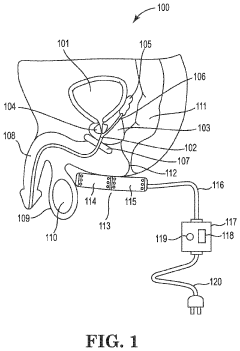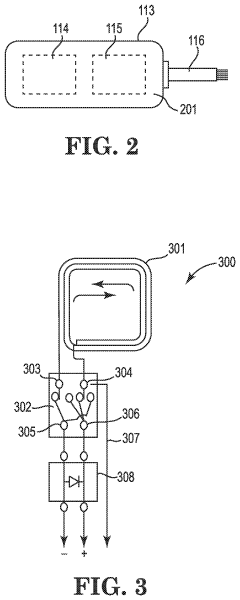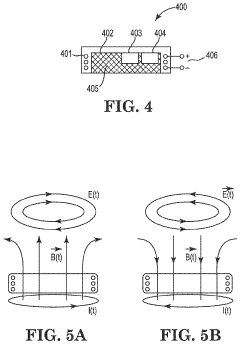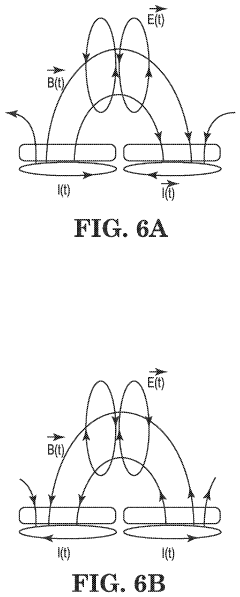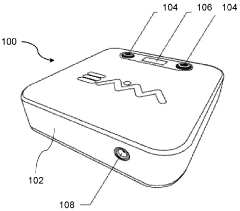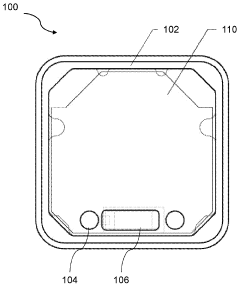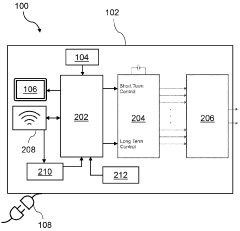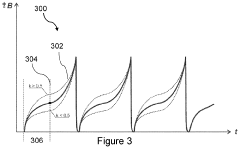Exploring PEMF Therapy's Role in Environmental Stress Adaptation
AUG 11, 20259 MIN READ
Generate Your Research Report Instantly with AI Agent
Patsnap Eureka helps you evaluate technical feasibility & market potential.
PEMF Therapy Background
Pulsed Electromagnetic Field (PEMF) therapy has emerged as a promising non-invasive treatment modality in recent decades. Rooted in the principles of electromagnetic field interactions with biological systems, PEMF therapy utilizes low-frequency electromagnetic fields to stimulate cellular functions and promote healing processes. The concept of using electromagnetic fields for therapeutic purposes dates back to the 18th century, but it wasn't until the mid-20th century that scientific research began to explore its potential systematically.
The fundamental principle behind PEMF therapy is based on the idea that all living cells possess electrical properties and are influenced by electromagnetic fields. By applying specific pulsed electromagnetic fields, PEMF therapy aims to restore or enhance cellular function, particularly in situations where normal cellular processes have been disrupted due to injury, disease, or environmental stressors.
In the context of environmental stress adaptation, PEMF therapy has gained attention for its potential to mitigate the negative effects of various environmental stressors on biological systems. These stressors can include factors such as pollution, radiation, extreme temperatures, and oxidative stress. The therapy's ability to modulate cellular responses and enhance the body's natural defense mechanisms makes it a subject of interest in addressing the challenges posed by increasingly stressful environmental conditions.
The development of PEMF therapy has been marked by significant technological advancements, moving from early, bulky devices to more sophisticated, portable systems. Modern PEMF devices can generate a wide range of frequencies and intensities, allowing for more targeted and personalized treatments. This evolution has expanded the potential applications of PEMF therapy across various fields, including orthopedics, neurology, and environmental medicine.
Research into PEMF therapy has shown promising results in areas such as pain management, bone healing, and tissue regeneration. However, its role in environmental stress adaptation is a relatively new area of exploration. Initial studies suggest that PEMF therapy may help enhance cellular resilience to environmental stressors by improving mitochondrial function, reducing oxidative stress, and modulating inflammatory responses.
As environmental challenges continue to grow in complexity and severity, the potential of PEMF therapy to support biological adaptation and resilience becomes increasingly relevant. This technology offers a unique approach to addressing the physiological impacts of environmental stress, potentially complementing other strategies in environmental health and medicine.
The fundamental principle behind PEMF therapy is based on the idea that all living cells possess electrical properties and are influenced by electromagnetic fields. By applying specific pulsed electromagnetic fields, PEMF therapy aims to restore or enhance cellular function, particularly in situations where normal cellular processes have been disrupted due to injury, disease, or environmental stressors.
In the context of environmental stress adaptation, PEMF therapy has gained attention for its potential to mitigate the negative effects of various environmental stressors on biological systems. These stressors can include factors such as pollution, radiation, extreme temperatures, and oxidative stress. The therapy's ability to modulate cellular responses and enhance the body's natural defense mechanisms makes it a subject of interest in addressing the challenges posed by increasingly stressful environmental conditions.
The development of PEMF therapy has been marked by significant technological advancements, moving from early, bulky devices to more sophisticated, portable systems. Modern PEMF devices can generate a wide range of frequencies and intensities, allowing for more targeted and personalized treatments. This evolution has expanded the potential applications of PEMF therapy across various fields, including orthopedics, neurology, and environmental medicine.
Research into PEMF therapy has shown promising results in areas such as pain management, bone healing, and tissue regeneration. However, its role in environmental stress adaptation is a relatively new area of exploration. Initial studies suggest that PEMF therapy may help enhance cellular resilience to environmental stressors by improving mitochondrial function, reducing oxidative stress, and modulating inflammatory responses.
As environmental challenges continue to grow in complexity and severity, the potential of PEMF therapy to support biological adaptation and resilience becomes increasingly relevant. This technology offers a unique approach to addressing the physiological impacts of environmental stress, potentially complementing other strategies in environmental health and medicine.
Market Analysis
The market for PEMF (Pulsed Electromagnetic Field) therapy in environmental stress adaptation is experiencing significant growth, driven by increasing awareness of environmental stressors and their impact on human health. As urbanization and industrialization continue to rise globally, individuals are exposed to a variety of environmental stressors, including air pollution, electromagnetic radiation, and climate change-related factors. This has created a growing demand for innovative solutions to mitigate the negative effects of these stressors on human health and well-being.
The PEMF therapy market for environmental stress adaptation is currently in its early stages but shows promising potential. Market research indicates that the global PEMF therapy devices market is expected to grow at a compound annual growth rate (CAGR) of over 5% in the coming years. While this figure encompasses all applications of PEMF therapy, the segment focused on environmental stress adaptation is likely to see even higher growth rates due to increasing environmental concerns and the need for preventive health measures.
Key market drivers include the rising prevalence of stress-related disorders, growing consumer interest in non-invasive and drug-free therapies, and increasing research supporting the efficacy of PEMF therapy in stress reduction and cellular regeneration. The market is also benefiting from technological advancements in PEMF devices, making them more portable, user-friendly, and affordable for personal use.
Geographically, North America and Europe currently dominate the PEMF therapy market, owing to higher awareness levels and greater healthcare expenditure. However, Asia-Pacific is emerging as a rapidly growing market, driven by increasing pollution levels in developing countries and a growing middle-class population seeking preventive health solutions.
The target consumer base for PEMF therapy in environmental stress adaptation is diverse, ranging from individuals living in highly polluted urban areas to those exposed to high levels of electromagnetic radiation in their work environments. Additionally, there is growing interest from healthcare providers, wellness centers, and corporate wellness programs looking to offer holistic solutions for stress management and overall health improvement.
Despite the positive outlook, the market faces challenges such as limited public awareness, skepticism about alternative therapies, and the need for more extensive clinical research to validate the effectiveness of PEMF therapy specifically for environmental stress adaptation. Regulatory hurdles and varying approval processes across different countries also pose challenges for market expansion.
In conclusion, the market for PEMF therapy in environmental stress adaptation presents significant opportunities for growth and innovation. As environmental stressors continue to impact global health, the demand for effective, non-invasive solutions is likely to increase, positioning PEMF therapy as a promising technology in this emerging market segment.
The PEMF therapy market for environmental stress adaptation is currently in its early stages but shows promising potential. Market research indicates that the global PEMF therapy devices market is expected to grow at a compound annual growth rate (CAGR) of over 5% in the coming years. While this figure encompasses all applications of PEMF therapy, the segment focused on environmental stress adaptation is likely to see even higher growth rates due to increasing environmental concerns and the need for preventive health measures.
Key market drivers include the rising prevalence of stress-related disorders, growing consumer interest in non-invasive and drug-free therapies, and increasing research supporting the efficacy of PEMF therapy in stress reduction and cellular regeneration. The market is also benefiting from technological advancements in PEMF devices, making them more portable, user-friendly, and affordable for personal use.
Geographically, North America and Europe currently dominate the PEMF therapy market, owing to higher awareness levels and greater healthcare expenditure. However, Asia-Pacific is emerging as a rapidly growing market, driven by increasing pollution levels in developing countries and a growing middle-class population seeking preventive health solutions.
The target consumer base for PEMF therapy in environmental stress adaptation is diverse, ranging from individuals living in highly polluted urban areas to those exposed to high levels of electromagnetic radiation in their work environments. Additionally, there is growing interest from healthcare providers, wellness centers, and corporate wellness programs looking to offer holistic solutions for stress management and overall health improvement.
Despite the positive outlook, the market faces challenges such as limited public awareness, skepticism about alternative therapies, and the need for more extensive clinical research to validate the effectiveness of PEMF therapy specifically for environmental stress adaptation. Regulatory hurdles and varying approval processes across different countries also pose challenges for market expansion.
In conclusion, the market for PEMF therapy in environmental stress adaptation presents significant opportunities for growth and innovation. As environmental stressors continue to impact global health, the demand for effective, non-invasive solutions is likely to increase, positioning PEMF therapy as a promising technology in this emerging market segment.
Technical Challenges
The exploration of PEMF (Pulsed Electromagnetic Field) therapy for environmental stress adaptation faces several technical challenges that need to be addressed for its effective implementation and widespread adoption. One of the primary obstacles is the lack of standardization in PEMF devices and treatment protocols. The wide variety of frequencies, intensities, and waveforms used in different PEMF systems makes it difficult to compare results across studies and establish optimal parameters for specific environmental stressors.
Another significant challenge lies in the complexity of biological systems and their responses to electromagnetic fields. The mechanisms by which PEMF therapy influences cellular processes and stress adaptation are not fully understood, making it challenging to design targeted interventions for specific environmental stressors. This knowledge gap hinders the development of more effective and efficient PEMF therapies.
The issue of dosimetry and precise measurement of electromagnetic field exposure within biological tissues presents a technical hurdle. Accurate quantification of the electromagnetic field strength and distribution in the body is crucial for determining the optimal dose and treatment duration. However, current measurement techniques are limited in their ability to provide real-time, non-invasive assessments of field penetration and interaction with tissues.
Developing PEMF devices that are both portable and powerful enough to induce significant biological effects poses another technical challenge. The need for compact, energy-efficient systems that can deliver therapeutic electromagnetic fields over extended periods is crucial for applications in environmental stress adaptation, particularly in remote or resource-limited settings.
The integration of PEMF therapy with other stress adaptation techniques and technologies presents both opportunities and challenges. Synergizing PEMF with nutritional interventions, pharmacological approaches, or other biophysical therapies requires a deep understanding of potential interactions and the development of sophisticated, multi-modal treatment systems.
Ensuring the long-term safety and efficacy of PEMF therapy for environmental stress adaptation is another critical challenge. While short-term studies have shown promising results, the potential long-term effects of chronic electromagnetic field exposure on human health and the environment need to be thoroughly investigated and monitored.
Lastly, the development of personalized PEMF therapies tailored to individual genetic profiles, physiological states, and specific environmental stressors represents a significant technical hurdle. This requires advanced biosensing technologies, data analytics, and machine learning algorithms to interpret complex biological responses and optimize treatment parameters in real-time.
Another significant challenge lies in the complexity of biological systems and their responses to electromagnetic fields. The mechanisms by which PEMF therapy influences cellular processes and stress adaptation are not fully understood, making it challenging to design targeted interventions for specific environmental stressors. This knowledge gap hinders the development of more effective and efficient PEMF therapies.
The issue of dosimetry and precise measurement of electromagnetic field exposure within biological tissues presents a technical hurdle. Accurate quantification of the electromagnetic field strength and distribution in the body is crucial for determining the optimal dose and treatment duration. However, current measurement techniques are limited in their ability to provide real-time, non-invasive assessments of field penetration and interaction with tissues.
Developing PEMF devices that are both portable and powerful enough to induce significant biological effects poses another technical challenge. The need for compact, energy-efficient systems that can deliver therapeutic electromagnetic fields over extended periods is crucial for applications in environmental stress adaptation, particularly in remote or resource-limited settings.
The integration of PEMF therapy with other stress adaptation techniques and technologies presents both opportunities and challenges. Synergizing PEMF with nutritional interventions, pharmacological approaches, or other biophysical therapies requires a deep understanding of potential interactions and the development of sophisticated, multi-modal treatment systems.
Ensuring the long-term safety and efficacy of PEMF therapy for environmental stress adaptation is another critical challenge. While short-term studies have shown promising results, the potential long-term effects of chronic electromagnetic field exposure on human health and the environment need to be thoroughly investigated and monitored.
Lastly, the development of personalized PEMF therapies tailored to individual genetic profiles, physiological states, and specific environmental stressors represents a significant technical hurdle. This requires advanced biosensing technologies, data analytics, and machine learning algorithms to interpret complex biological responses and optimize treatment parameters in real-time.
Current PEMF Solutions
01 PEMF therapy for stress reduction and adaptation
Pulsed electromagnetic field (PEMF) therapy can be used to reduce environmental stress and promote adaptation. This therapy involves applying electromagnetic fields to the body, which can help regulate stress responses, improve cellular function, and enhance overall well-being. PEMF therapy may assist in adapting to various environmental stressors by modulating physiological processes and supporting the body's natural healing mechanisms.- PEMF therapy for stress reduction and adaptation: Pulsed electromagnetic field (PEMF) therapy can be used to reduce environmental stress and promote adaptation. This therapy involves applying electromagnetic fields to the body, which can help regulate stress responses, improve cellular function, and enhance overall well-being. PEMF therapy may assist in adapting to various environmental stressors by modulating physiological processes.
- Genetic modification for environmental stress tolerance: Genetic engineering techniques can be employed to enhance plants' ability to adapt to environmental stresses. This approach involves modifying genes related to stress response pathways, potentially improving tolerance to factors such as drought, salinity, or extreme temperatures. Such modifications can lead to the development of crops with increased resilience to challenging environmental conditions.
- Electromagnetic field exposure for cellular adaptation: Controlled exposure to electromagnetic fields can induce adaptive responses at the cellular level. This process may involve changes in gene expression, protein synthesis, and cellular signaling pathways. By carefully modulating electromagnetic field exposure, it may be possible to enhance cellular resilience and adaptation to various environmental stressors.
- Combination of PEMF therapy with other stress-reduction techniques: Integrating PEMF therapy with other stress-reduction methods can potentially enhance overall adaptation to environmental stressors. This approach may include combining PEMF treatment with techniques such as meditation, biofeedback, or specific dietary interventions. The synergistic effect of these combined therapies could provide a more comprehensive approach to stress adaptation.
- PEMF devices for personalized stress adaptation: Development of personalized PEMF devices that can be tailored to individual stress responses and environmental conditions. These devices may incorporate sensors to monitor physiological parameters and adjust PEMF parameters accordingly. This personalized approach aims to optimize the effectiveness of PEMF therapy in promoting adaptation to specific environmental stressors.
02 PEMF devices for environmental stress management
Specialized PEMF devices can be designed for managing environmental stress. These devices may incorporate features such as adjustable field strengths, programmable treatment protocols, and portable designs for use in various environments. The devices can be tailored to address specific environmental stressors and support the body's adaptive responses, potentially improving resilience to challenging conditions.Expand Specific Solutions03 Combining PEMF therapy with other stress adaptation techniques
PEMF therapy can be integrated with other stress adaptation techniques to enhance overall effectiveness. This may include combining PEMF treatments with relaxation exercises, biofeedback, or other complementary therapies. The synergistic approach can potentially provide more comprehensive support for environmental stress adaptation and improve overall outcomes.Expand Specific Solutions04 PEMF therapy for specific environmental stressors
PEMF therapy can be tailored to address specific environmental stressors such as electromagnetic pollution, climate extremes, or high-altitude conditions. By adjusting the parameters of the electromagnetic fields, PEMF treatments can be optimized to support the body's adaptation to these particular environmental challenges, potentially mitigating their negative effects on health and well-being.Expand Specific Solutions05 Monitoring and optimizing PEMF therapy for stress adaptation
Advanced monitoring systems and optimization techniques can be employed to enhance the effectiveness of PEMF therapy for environmental stress adaptation. This may involve real-time tracking of physiological responses, adaptive treatment protocols, and personalized therapy adjustments based on individual needs and environmental conditions. Such approaches can help maximize the benefits of PEMF therapy in supporting stress adaptation and resilience.Expand Specific Solutions
Key Industry Players
The exploration of PEMF therapy's role in environmental stress adaptation is in its early stages, with the market showing promising growth potential. The technology is gaining traction due to its potential applications in healthcare and wellness sectors. Companies like Venus Concept Ltd. and Regenesis Biomedical, Inc. are at the forefront, developing innovative PEMF devices. Research institutions such as the National University of Singapore and the Swiss Federal Institute of Technology are contributing to the scientific understanding of PEMF's effects on stress adaptation. While the technology is still maturing, collaborations between industry players and academic institutions are driving advancements, indicating a competitive landscape poised for significant developments in the coming years.
National University of Singapore
Technical Solution: National University of Singapore (NUS) has been exploring PEMF therapy's role in environmental stress adaptation through innovative research approaches. Their studies focus on the cellular and molecular mechanisms by which PEMF influences stress responses. NUS researchers have developed a novel PEMF delivery system that can be precisely controlled and modulated to target specific stress pathways[1]. This system allows for the investigation of PEMF effects on various environmental stressors, including oxidative stress, heat shock, and chemical toxins. The university's research has shown that PEMF therapy can enhance cellular resilience by upregulating stress response genes and antioxidant pathways[2]. Additionally, NUS has conducted in vivo studies demonstrating PEMF's potential in mitigating the effects of environmental pollutants on organ systems[3].
Strengths: Cutting-edge research facilities, multidisciplinary approach combining biology, physics, and engineering. Weaknesses: Limited clinical translation of research findings, potential regulatory hurdles for PEMF devices.
Swiss Federal Institute of Technology
Technical Solution: The Swiss Federal Institute of Technology (ETH Zurich) has made significant strides in understanding PEMF therapy's role in environmental stress adaptation. Their research team has developed advanced computational models to simulate the interaction between PEMF and biological systems under various environmental stressors[4]. These models have enabled the optimization of PEMF parameters for specific stress conditions. ETH Zurich has also pioneered the use of nanotechnology in PEMF therapy, creating nanoparticle-based PEMF enhancers that can target specific tissues or cell types[5]. Their studies have shown promising results in enhancing plant resistance to drought and temperature extremes using PEMF technology[6]. Furthermore, the institute has conducted human trials investigating PEMF's potential in mitigating the effects of high-altitude stress on cognitive function and physiological parameters.
Strengths: Strong interdisciplinary collaboration, advanced computational and nanotechnology capabilities. Weaknesses: High cost of research infrastructure, potential challenges in scaling up nanoparticle-based PEMF technologies.
Core PEMF Innovations
Method and apparatus for treatment of benign prostatic hyperplasia (BPH)
PatentInactiveUS20230398368A1
Innovation
- A non-invasive method utilizing pulsed electromagnetic field (PEMF) stimulation to increase the number of A2a receptors on cell membranes, enhancing the anti-inflammatory effects of adenosine and providing immunosuppressive action to reduce chronic inflammation and tissue damage in the prostate.
A pulsed electromagnetic field apparatus and method for generating frequencies
PatentWO2024127242A1
Innovation
- A PEMF apparatus with a pulse generator and electromagnetic field generation means that uses modified sawtooth waveforms with pre-stress and relaxation periods, and quasi-sine signals with pulse width modulation, along with a feedback circuit for frequency stability and precision, and a bifilar antenna for scalar wave generation.
Regulatory Framework
The regulatory framework surrounding Pulsed Electromagnetic Field (PEMF) therapy in the context of environmental stress adaptation is complex and evolving. In the United States, the Food and Drug Administration (FDA) plays a crucial role in overseeing PEMF devices. Currently, the FDA has approved several PEMF devices for specific medical applications, such as bone healing and pain management. However, the use of PEMF for environmental stress adaptation falls into a regulatory gray area.
The FDA classifies PEMF devices into different categories based on their intended use and potential risks. Class I devices are considered low-risk and are subject to general controls. Class II devices require special controls and premarket notification (510(k)), while Class III devices necessitate premarket approval (PMA). The classification of PEMF devices for environmental stress adaptation would likely depend on the specific claims made and the intended use of the device.
Internationally, regulatory approaches to PEMF therapy vary. The European Union, through its Medical Device Regulation (MDR), has established guidelines for the classification and approval of PEMF devices. In contrast, some countries have less stringent regulations, potentially allowing for more rapid adoption of PEMF technology in environmental stress adaptation applications.
One of the key challenges in regulating PEMF therapy for environmental stress adaptation is the lack of standardized protocols and dosage guidelines. This absence of standardization makes it difficult for regulatory bodies to assess the safety and efficacy of these devices consistently. As research in this field progresses, it is likely that regulatory frameworks will need to adapt to accommodate new findings and applications.
The regulatory landscape also intersects with intellectual property considerations. Patents related to PEMF technology and its applications in environmental stress adaptation can influence the development and commercialization of new devices. Companies and researchers must navigate both regulatory requirements and patent landscapes to bring innovative PEMF solutions to market.
As the potential applications of PEMF therapy in environmental stress adaptation continue to expand, regulatory bodies may need to develop new guidelines specifically tailored to this emerging field. This could involve collaboration between health authorities, environmental agencies, and scientific experts to establish appropriate safety standards and efficacy criteria.
The FDA classifies PEMF devices into different categories based on their intended use and potential risks. Class I devices are considered low-risk and are subject to general controls. Class II devices require special controls and premarket notification (510(k)), while Class III devices necessitate premarket approval (PMA). The classification of PEMF devices for environmental stress adaptation would likely depend on the specific claims made and the intended use of the device.
Internationally, regulatory approaches to PEMF therapy vary. The European Union, through its Medical Device Regulation (MDR), has established guidelines for the classification and approval of PEMF devices. In contrast, some countries have less stringent regulations, potentially allowing for more rapid adoption of PEMF technology in environmental stress adaptation applications.
One of the key challenges in regulating PEMF therapy for environmental stress adaptation is the lack of standardized protocols and dosage guidelines. This absence of standardization makes it difficult for regulatory bodies to assess the safety and efficacy of these devices consistently. As research in this field progresses, it is likely that regulatory frameworks will need to adapt to accommodate new findings and applications.
The regulatory landscape also intersects with intellectual property considerations. Patents related to PEMF technology and its applications in environmental stress adaptation can influence the development and commercialization of new devices. Companies and researchers must navigate both regulatory requirements and patent landscapes to bring innovative PEMF solutions to market.
As the potential applications of PEMF therapy in environmental stress adaptation continue to expand, regulatory bodies may need to develop new guidelines specifically tailored to this emerging field. This could involve collaboration between health authorities, environmental agencies, and scientific experts to establish appropriate safety standards and efficacy criteria.
Environmental Impact
The environmental impact of PEMF (Pulsed Electromagnetic Field) therapy in the context of environmental stress adaptation is a multifaceted topic that warrants careful consideration. As organisms face increasing environmental stressors due to climate change and human activities, the potential of PEMF therapy to enhance adaptive responses becomes increasingly relevant.
PEMF therapy's influence on environmental stress adaptation primarily stems from its ability to modulate cellular processes and physiological responses. By applying low-frequency electromagnetic fields, PEMF therapy can potentially enhance an organism's resilience to various environmental stressors, including temperature fluctuations, UV radiation, and pollutants.
One of the key mechanisms through which PEMF therapy may contribute to environmental stress adaptation is by promoting cellular repair and regeneration. Environmental stressors often lead to oxidative stress and cellular damage. PEMF therapy has been shown to stimulate antioxidant defense mechanisms and enhance DNA repair processes, potentially mitigating the harmful effects of environmental toxins and radiation.
Furthermore, PEMF therapy may play a role in improving an organism's ability to regulate its internal environment in response to external changes. Studies have suggested that PEMF exposure can influence the hypothalamic-pituitary-adrenal (HPA) axis, which is crucial for stress response and adaptation. By modulating the HPA axis, PEMF therapy could potentially enhance an organism's capacity to cope with environmental stressors.
The application of PEMF therapy in agriculture and ecosystem management presents an intriguing avenue for environmental impact. Preliminary research indicates that PEMF treatment may enhance plant growth and stress tolerance, potentially leading to more resilient crops in the face of changing climatic conditions. This could have far-reaching implications for food security and sustainable agriculture practices.
However, it is essential to consider the potential ecological consequences of widespread PEMF application. While the therapy may benefit target organisms, its effects on non-target species and overall ecosystem dynamics remain largely unexplored. The introduction of artificial electromagnetic fields into natural environments could potentially disrupt delicate ecological balances and impact biodiversity.
As research in this field progresses, it will be crucial to conduct comprehensive environmental impact assessments to fully understand the long-term effects of PEMF therapy on ecosystems and biodiversity. These assessments should consider both the direct effects on target organisms and the indirect impacts on ecosystem functioning and species interactions.
In conclusion, while PEMF therapy shows promise in enhancing environmental stress adaptation, its broader environmental impact requires careful evaluation. Balancing the potential benefits with ecological considerations will be essential in determining the role of PEMF therapy in addressing environmental challenges and promoting sustainable adaptation strategies.
PEMF therapy's influence on environmental stress adaptation primarily stems from its ability to modulate cellular processes and physiological responses. By applying low-frequency electromagnetic fields, PEMF therapy can potentially enhance an organism's resilience to various environmental stressors, including temperature fluctuations, UV radiation, and pollutants.
One of the key mechanisms through which PEMF therapy may contribute to environmental stress adaptation is by promoting cellular repair and regeneration. Environmental stressors often lead to oxidative stress and cellular damage. PEMF therapy has been shown to stimulate antioxidant defense mechanisms and enhance DNA repair processes, potentially mitigating the harmful effects of environmental toxins and radiation.
Furthermore, PEMF therapy may play a role in improving an organism's ability to regulate its internal environment in response to external changes. Studies have suggested that PEMF exposure can influence the hypothalamic-pituitary-adrenal (HPA) axis, which is crucial for stress response and adaptation. By modulating the HPA axis, PEMF therapy could potentially enhance an organism's capacity to cope with environmental stressors.
The application of PEMF therapy in agriculture and ecosystem management presents an intriguing avenue for environmental impact. Preliminary research indicates that PEMF treatment may enhance plant growth and stress tolerance, potentially leading to more resilient crops in the face of changing climatic conditions. This could have far-reaching implications for food security and sustainable agriculture practices.
However, it is essential to consider the potential ecological consequences of widespread PEMF application. While the therapy may benefit target organisms, its effects on non-target species and overall ecosystem dynamics remain largely unexplored. The introduction of artificial electromagnetic fields into natural environments could potentially disrupt delicate ecological balances and impact biodiversity.
As research in this field progresses, it will be crucial to conduct comprehensive environmental impact assessments to fully understand the long-term effects of PEMF therapy on ecosystems and biodiversity. These assessments should consider both the direct effects on target organisms and the indirect impacts on ecosystem functioning and species interactions.
In conclusion, while PEMF therapy shows promise in enhancing environmental stress adaptation, its broader environmental impact requires careful evaluation. Balancing the potential benefits with ecological considerations will be essential in determining the role of PEMF therapy in addressing environmental challenges and promoting sustainable adaptation strategies.
Unlock deeper insights with Patsnap Eureka Quick Research — get a full tech report to explore trends and direct your research. Try now!
Generate Your Research Report Instantly with AI Agent
Supercharge your innovation with Patsnap Eureka AI Agent Platform!
